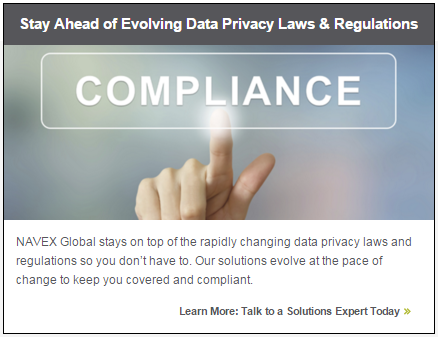To help prepare compliance professionals for the year ahead, we’ve talked with industry experts, our colleagues at NAVEX Global, and ethics and compliance professionals from our more than 12,500 client organizations to gather insights on the top issues and trends that will impact compliance programs in 2016. We’ll share each of the trends here over the next few weeks.
By now, most organizations understand the importance of identifying and addressing any exposure they have to violations of anti-corruption and bribery (ABC) laws. Much attention has been given to recent cases, and to enforcement of the U.S. Foreign Corrupt Practices Act (FCPA) and the U.K.’s Bribery Act.
Recently, Ben Morgan, Joint Head of the U.K. Serious Fraud Office Bribery and Corruption Unit, urged organizations to voluntarily come forward now with any information they have about past corrupt practices—or face the full force of his office later.
This certainly underscores the need to make bribery and corruption a priority. For those who may still think concerns about ABC risks are exaggerated, consider the findings of the 2015 KPMG survey on the topic. Its findings, based on a survey of 659 risk managers, include:
- Compared with a KPMG survey four years ago, there was a sharp increase in the proportion of respondents who say they are highly challenged by the issue of ABC.
- As organizations continue to globalize, management of third parties poses the greatest challenge in executing ABC programs.
- Despite the difficulty of monitoring their business dealings with third parties, more than one third of respondents do not formally identify high-risk third parties. More than half of those respondents with right-to-audit clauses over third parties have not exercised the right.
- ABC considerations are accorded too low a priority by organizations preparing to acquire, or merge with, other corporations across borders.
- Respondents complain they lack the resources to manage ABC risk.
- A top-down risk assessment would help organizations set priorities, but executives admit that an ABC risk assessment is one of their organizations’ top challenges.

These findings demonstrate the critical need for companies to identify and address ABC risks and the roles third parties play in these risks. It is often daunting or overwhelming for organizations to develop and undertake a program. However, doing nothing is not an acceptable defense.
Key Steps for Organizations to Take
1. Conduct a robust corporate risk assessment.
Your risk assessment should not only identify key risk areas, but also cite plans to mitigate or reduce risk to acceptable levels. The process should first involve document reviews. Then, surveys and interviews with subject matter experts and compliance stakeholders can evaluate the likelihood, magnitude and mitigating controls of various risks.
2. Review your ABC mitigation plan for completeness.
The mitigation steps you develop based on your risk assessment should be organized into an efficient ABC program. This is not separate from your overall E&C program, but is a plan that describes how various E&C controls and resources are being deployed to address the ABC risks.
In 2012 the U.S. Department of Justice and U.S. SEC published a useful tool to evaluate the completeness of your ABC efforts.
3. Identify and address your organization’s third party risks.
This is often the most challenging step to take. There are often hundreds or even thousands of third parties considered or engaged by organizations for both routine and episodic roles.
Though challenging, an ABC mitigation plan isn’t complete unless it tackles third-party exposure. The FCPA Guide suggests that every compliance program should address the following guiding principles:
- As part of risk-based due diligence, understand the qualifications and associates of the organization’s third parties. Scrutiny should increase as “red flags” surface.
- Understand the business rationale for including a third party in the transaction.
- Undertake some form of ongoing monitoring of third party relationships.
- Inform the third party of the organization’s compliance program and commitment to ethical and lawful business practices.
4. Create or update written policies and procedures to address these risks—particularly the highest risks.
The best practice is to use policy management software to assist in this process. A centralized database should be easily accessible to users; regularly updated; confirm and track applicable policy updates, training and investigations.
There is no need to boil the ocean—but you must turn on the stove. The best way to address many of these concerns is to devise a plan to implement changes in demonstrable stages—and determine how technology can help you create significantly stronger third party due diligence and risk assessment programs while making them more efficient and defensible.
For guidance on effective third party risk management policy and procedure, connect with an ethics and compliance expert today.









